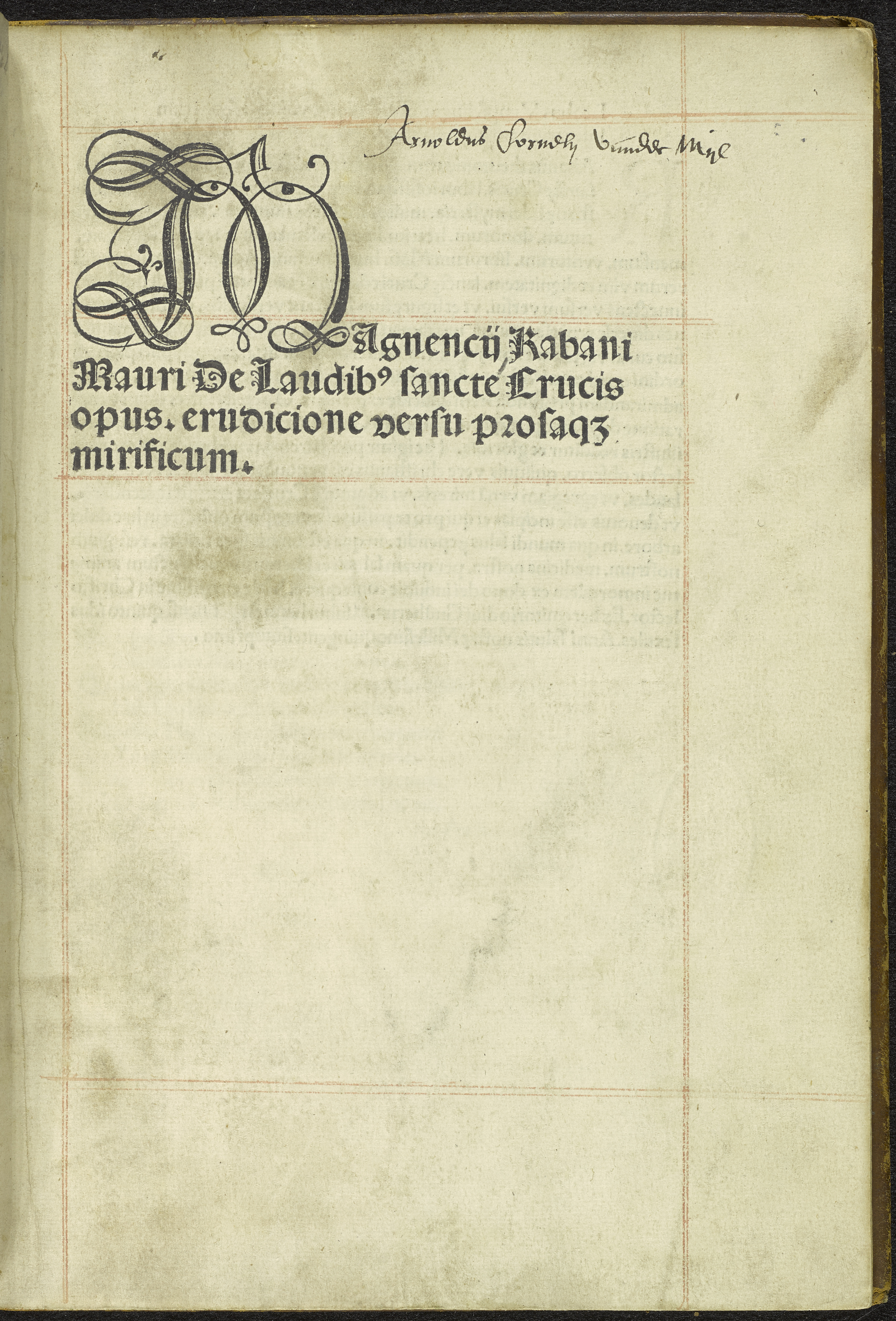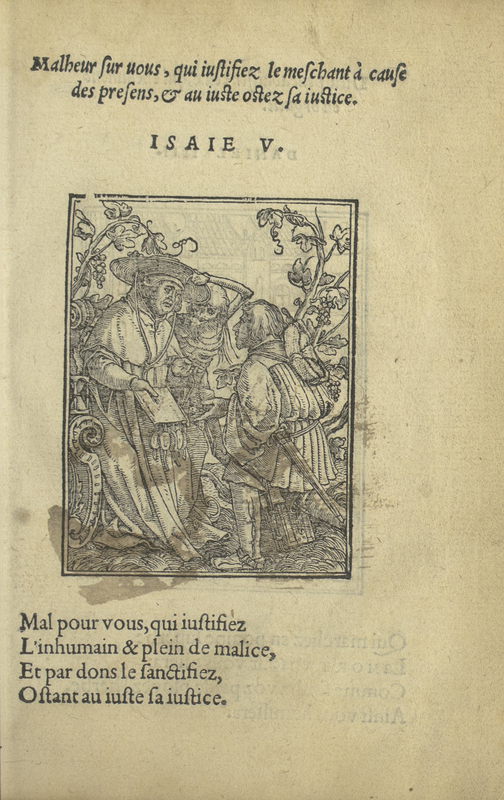Richard C. Kessler Reformation Collection
The Richard C. Kessler Reformation Collection was established in 1987, when Richard and Martha Kessler donated their private collection of Reformation imprints and manuscripts to Emory University. These materials were combined with Reformation holdings at the Pitts Theology Library, and an effort was launched to enlarge and sustain this collection in the years to come. An advisory committee of Lutheran laypersons and clergy and of Candler School of Theology faculty and administrators oversees the nurture of the collection and its programs. The Reformation Notes newsletter provides semiannual updates on the growth of the collection, and the Reformation Day at Emory program of music and lectures each October celebrates the collection and its contributions to music, history, and theology. In the sixteenth century the social and theological movements of central Europe, known collectively as the Reformation, critically shaped religion, law, education and other institutions in the West, and their long shadow has extended even to the present. The purpose of the Kessler Collection is to document these changes by collecting print and manuscript materials down to 1570 by Martin Luther (1483-1546) and those whom he influenced or engaged in debate. In this way historians and theologians will be able to hear the full range of voices that were raised in this dynamic period. The holdings of the collection now exceed 4,000 items, a mark approximated by only two other libraries in North America; no American library approaches the Kessler Collection's 1,000+ publications by Luther himself.
-
 Text
TextVszlegung dütsch des Vatter vnser für die einfeltigen leyen
Luther, Martin, 1483-1546Summary: This exposition of the Lord's Prayer had its origins in a series of sermons preached by Luther during Lent, 1517. J. Agricola published his transcripts of these sermons. Luther was dissatisfied with Agricola's edition, however, and re-edited the work. This example is from the seventh printing of Luther's edition. -
 Text
TextDoctor Martinus Luther Augustiners Vnterricht auff etlich Artickell die im vonn seynen Abgūrnern auff gelegt vn[d] zu gemessen werden
Luther, Martin, 1483-1546Summary: Luther was persuaded by Karl von Miltitz to write this public statement as a response to certain charges brought against him by his opponents, in particular Mazzolini da Prierio. In this tract, Luther still supports the invocation of the saints, an idea which he abandoned only shortly after. -
 Text
TextStella clericorum cuilib[et] clerico summe necessaria
Summary: "Star of the Clergy" is an anonymous handbook on pastoral care. This manual was widely printed and copied. Lotter, the Leipzig printer who produced this edition, also published Luther's first work. -
 Text
TextMagnencij Rabani Mauri de laudi[bus] Sancte Crucis opus. : erudicione versu posa[que] mirificum
Rabanus Maurus, Archbishop of Mainz, 784?-856Summary: De laudibus sanctae crucis (On the praise of the Holy Cross) is a collection of poems and figures, including geometric shapes, letters, drawings and even complex miniatures produced in the early 9th century in the scriptorium of the Abbey at Fulda under the direction of Hrabanus Maurus, archbishop of Mainz, who also provided the commentary found in the work. The book is an important testimony to Carolingian book art. -
![A woodcut border to Tommaso de Vio Cajetan's De diuina institutione Pontificatus Romani Pontificis super tota[m] ecclesiam: a Christo in Petro printed in 1521. The border consists of four separate woodcuts depicting floral and decorative column motifs.](https://s3.us-west-2.amazonaws.com/omekacloud-main/large/P_000015281797_P005/P_000015281797_P005_PROD.jpg) Still image
Still imageHistoriated title page border of Tommaso de Vio Cajetan's De diuina institutione Pontificatus Romani Pontificis super tota[m] ecclesiam: a Christo in Petro
A woodcut border to Tommaso de Vio Cajetan's De diuina institutione Pontificatus Romani Pontificis super tota[m] ecclesiam: a Christo in Petro printed in 1521. The border consists of four separate woodcuts depicting floral and decorative column motifs. -
 Still image
Still imageThe Cardinal
Holbein, Hans, 1497-1543A woodcut depicting a cardinal talking to a lay person amidst a vinyard while a skeleton reaches for the cardinal's hat. The woodcut is accompanied by a verse from Isaiah 5:7 translated into French (top) and then reformatted into verse (bottom). -
 Text
TextGeistliche Lieder zu Wittemberg / Anno 1543
Luther, Martin, 1483-1546Summary: Joseph Klug printed the first collection of hymns that Luther prepared specifically for congregational use in Wittenberg in 1529. It followed the church year closely and was revised and reprinted several times. The renowned hymnal printed by Valentin Bapst (Geystlicher Lieder'; Leipzig, 1545) may be seen as a later edition of the Klug hymnal. (Robin Leaver, "Hymnals," in 'The Oxford Encyclopedia of the Reformation' (1996) 2:286-89.) -
 Still image
Still imageHistoriated title page border of Luther's Eyn brieff an die Fürsten zu Sachsen von dem auffrurischen geyst
A woodcut border to Luther's Eyn brieff an die Fürsten zu Sachsen von dem auffrurischen geyst printed in 1524. The border is composed of a single woodcut and depicts a cherub flanked by two deer (bottom), decorative plants (sides), and a cherub holding a blank shield flanked by two other cherubs (top). -
 Still image
Still imageHistoriated title page border of Luther's Wider den neuen Abgott und alten Teufel
A woodcut border to Luther's Wider den neuen Abgott und alten Teufel printed in 1524. The border is composed of a single woodcut depicting an architectural archway supported by Corinthian columns (all), a pair of cherubs holding staves (top corners), and a pair of cherubs holding a medallion with a blank shield (bottom). -
 Still image
Still imageHistoriated title page border of Luther's Ain Sermon uon der frucht vnd nutzbarkait des hayligen Sacraments
A woodcut border to Luther's Ain Sermon uon der frucht vnd nutzbarkait des hayligen Sacraments printed in 1524. The border is composed of a single woodcut and depicts a cherub flanked by two deer (bottom), decorative plants (sides), and a cherub holding a blank shield flanked by two other cherubs (top). -
 Still image
Still imageHistoriated title page border of Luther's Widder das blind vnd toll verdamnis der siebenzehen artickel von der elenden schendlichen vniuersitet zu Ingolstat ausgangen
A woodcut border to Luther's Widder das blind vnd toll verdamnis der siebenzehen artickel von der elenden schendlichen vniuersitet zu Ingolstat ausgangen printed in 1524. The border is composed of a single woodcut and depicts a cherub flanked by two deer (bottom), decorative plants (sides), and a cherub holding a blank shield flanked by two other cherubs (top). -
![A woodcut border to Luther's Eyn kurtze vnterichtu[n]g, warauff Christus seine Kirchen, oder Gemain gebawet hab printed in 1524. The border is composed of four separate woodcuts depicting God or Jesus Christ holding the globus cruciger (top), decorative pillars with fish and plant motifs (sides), and the scene of the woman and the dragon from Revelations 7 (bottom).](https://s3.us-west-2.amazonaws.com/omekacloud-main/large/P_000015281133_P005/P_000015281133_P005_PROD.jpg) Still image
Still imageHistoriated title page border of Luther's Eyn kurtze vnterichtu[n]g, warauff Christus seine Kirchen, oder Gemain gebawet hab
A woodcut border to Luther's Eyn kurtze vnterichtu[n]g, warauff Christus seine Kirchen, oder Gemain gebawet hab printed in 1524. The border is composed of four separate woodcuts depicting God or Jesus Christ holding the globus cruciger (top), decorative pillars with fish and plant motifs (sides), and the scene of the woman and the dragon from Revelations 7 (bottom). -
 Still image
Still imageA Monk and a Knight
A woodcut depicting a monk in conversation with a knight. The woodcut appears on the title page of Luther's letter to the head of the Teutonic Order of Knights arguing against the requirement of celibacy. -
 Still image
Still imageHistoriated title page border of Luther's letter to Duke Charles III of Savoy
A woodcut border to a German translation of Luther's letter to Duke Charles III of Savoy printed in 1524. The border consists of a single woodcut depicting an architectural arch or niche decorated with Corinthian columns (sides), a lady and a knight holding blank shields (top left and right), a pair of sirens holding a blank shield (top), a blank shield filled in with a hand-drawn symbol flanked by two cherubs playing the drums and flute (bottom). -
![A woodcut border to Luther's Eyn geschicht wie Got eyner Erbarn kloster Jungfrawe[n] ausgeholffen hat printed in 1524. The border is composed of a single woodcut and depicts a cherub flanked by two deer (bottom), decorative plants (sides), and a cherub holding a blank shield flanked by two other cherubs (top).](https://s3.us-west-2.amazonaws.com/omekacloud-main/large/P_000015291127_P003/P_000015291127_P003_PROD.jpg) Still image
Still imageHistoriated title page border of Luther's Eyn geschicht wie Got eyner Erbarn kloster Jungfrawe[n] ausgeholffen hat
A woodcut border to Luther's Eyn geschicht wie Got eyner Erbarn kloster Jungfrawe[n] ausgeholffen hat printed in 1524. The border is composed of a single woodcut and depicts a cherub flanked by two deer (bottom), decorative plants (sides), and a cherub holding a blank shield flanked by two other cherubs (top). -
 Still image
Still imageHistoriated title page border of Luther's An die herren Deutschs Ordens, das sy falsche keuschhait meyden
A woodcut border to Luther's An die herren Deutschs Ordens, das sy falsche keuschhait meyden printed in 1524. The border is composed of four separate woodcuts depicting a variety of floral and plant motifs. -
 Still image
Still imageHistoriated title page border of Zwei kaiserliche uneinige und widerwärtige Gebote den Luther betreffend
A woodcut border to Zwei kaiserliche uneinige und widerwärtige Gebote den Luther betreffend printed in 1524. The border is composed of four separate woodcuts depicting three cherubs holding a plaque with the date of publication (top), a pair of architectural elements with two men standing between pairs of columns and topped with a female and male siren respectively (sides), and a man's torso with plant-like limbs (bottom). -
 Still image
Still imageHistoriated title page border of Andreas Orisander's translation of the Catholic Baptism rites
A woodcut border to Andreas Orisander's German translation of the traditional Catholic Baptism rites printed in 1524. The border is composed of four separate woodcuts depicting a decorative arch and pair of orbs (top), decorative columns which include a secton suported by a male figure (sides), a floral pattern (possibly thistle) with a bird (bottom). In the center of the border, below the title, is a woodcut coat of arms for the city of Nuremberg. -
 Still image
Still imageHistoriated title page border of Wolfgang Capito's Was man halten, vnnd Antwurtten soll, von der spaltung zwischen Martin Luther, vnnd Andres Carolstadt
A woodcut border to Wolfgang Capito's Was man halten, vnnd Antwurtten soll, von der spaltung zwischen Martin Luther, vnnd Andres Carolstadt printed in 1524. The border is composed of a single woodcut and depicts a cherub flanked by two deer (bottom), decorative plants (sides), and a cherub holding a blank shield flanked by two other cherubs (top).

